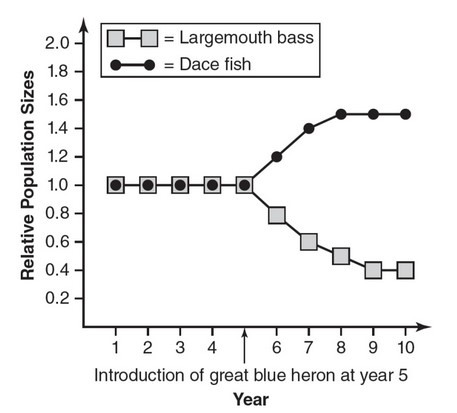Question
Largemouth bass (Micropterus salmoides) eat dace fish (Leuciscus leuciscus). Dace fish eat daphnia. Daphnia eat algae in the lake. The
number of largemouth bass and dace fish in a lake are recorded over a 10-year period. At year 5, great blue herons (Ardea Herodias) are
introduced to the lake. Great blue herons feed on young largemouth bass. The following graph shows the data regarding the relative
population sizes of the largemouth bass and dace fish over the 10-year period.
(a) Describe the trophic level of the dace fish in this ecosystem.
(b) Identify the independent variable and the dependent variable in this experiment.
(c) Analyze the data to determine the effect of the introduction of great blue herons on the population sizes of the largemouth bass and the dace fish.
(d) Predict the effect of the introduction of the great blue herons on the algae density in the lake. Justify your prediction.
▶️Answer/Explanation
Ans:
(a) The dace fish are secondary consumers because they eat daphnia,
which are primary consumers (that eat algae, which are the
producers). Dace fish are also the prey of the largemouth bass.
(b) The independent variable is the introduction of the great blue
herons. The dependent variable is the relative population sizes of
the largemouth bass and the dace fish.
(c) The introduction of the great blue herons reduced the relative
population size of the largemouth bass by about 40% and increased
the relative population size of the dace fish by about 40%. This is
because the great blue herons fed on the largemouth bass, reducing
their numbers. As a result of this decrease in largemouth bass, the
number of dace fish increased since there were no longer as many
predators (largemouth bass) to contend with.
(d) The algae density in the lake would increase. This is because algae
are consumed by daphnia and daphnia are consumed by dace fish.
If the numbers of dace fish increase (following the introduction of
the great blue herons), more daphnia will be consumed and there
will be fewer daphnia to consume the algae. Thus, the algae density
in the lake will increase.
Question
Biological oxygen demand (BOD) is the amount of dissolved oxygen needed by the organisms in a particular body of water to decompose the organic material present in a specified amount of time.
Explain how increasing the concentration of phosphorus in a lake creates a biological oxygen demand (BOD).
State one human activity that is likely to result in increased organic material in a body of water.
▶️Answer/Explanation
Ans:
Biological oxygen demand (BOD) is the amount of dissolved oxygen
needed by the organisms in a particular body of water to decompose the
organic material present in a specified amount of time. Eutrophication (or
hypertrophication) is the enrichment (or over-enrichment) of water by
nutrients. It results in excessive bacterial and/or algae growth, often called
blooms. When these organisms die, the oxidative breakdown of the detritus
leads to an oxygen shortage. Depletion of surface oxygen can suffocate fish
and other obligate aerobes.
Human activities that enrich bodies of water are dumping raw sewage
and farming in places where the runoff enters the drainage basin.
Question.
In a certain prairie community, a dominant prairie grass species has recently been infected with a virus that disrupts one of the electron transport proteins in the chloroplasts of infected cells.
(a) Describe the most likely effects on cellular processes (be specific as to which processes and molecules are most likely to be directly affected).
(b) Describe and explain the most likely effects on individual infected plants.
(c) Predict the short-term effects (within a year of infection) on the infected plant populations and their communities. Justify your prediction.
(d) Predict the long-term effects (years to decades after infection) on the infected plant populations and their communities. Justify your prediction.
▶️Answer/Explanation
(Part a)
Effects may include:
• Less ATP produced.
• Less NADPH produced.
• Inability to fix carbon via Calvin cycle without products of electron transport chain.
• Decrease in\( O_2\) production.
(Part b)
Explanations may include:
• Plant cannot produce glucose due to decrease in photosynthetic product
(G3P).
• Stunted growth due to lack of energy for building molecules.
• Plant becomes weakened and may die due to lack of ability to capture
energy.
• Plant uses up pre-infection energy stores.
• Cannot perform growth/repair/reproduction due to lack of usable energy.
(Part c)
Predictions may include:
• Reduction in population size of affected prairie grass due to death of
infected members.
• Decrease in consumer population size as less energy available for the
higher trophic levels.
• Smaller herbivore population size due to increased competition for limited
resources.
• Unaffected plant species gain resources due to loss of infected plants.
• Uninfected plants have increased offspring due to more available resources.
(Part d)
Predictions may include:
• Plant species becomes locally extinct.
• Reduction in genetic variability due to loss of infected plants.
• Change in allele frequencies for the affected species.
• Loss of consumer species dependent on affected prairie grass species.
• Members of the affected species with a genotype conferring resistance
become more common, leading to no long-term effects to the population
or community.
• Grass is replaced by other species — community is stabilized, or some
changes in members of the food chain.
• Increased erosion due to lack of grass leading to degradation of abiotic
environment, further limiting the ability of the environment to support
the community.
